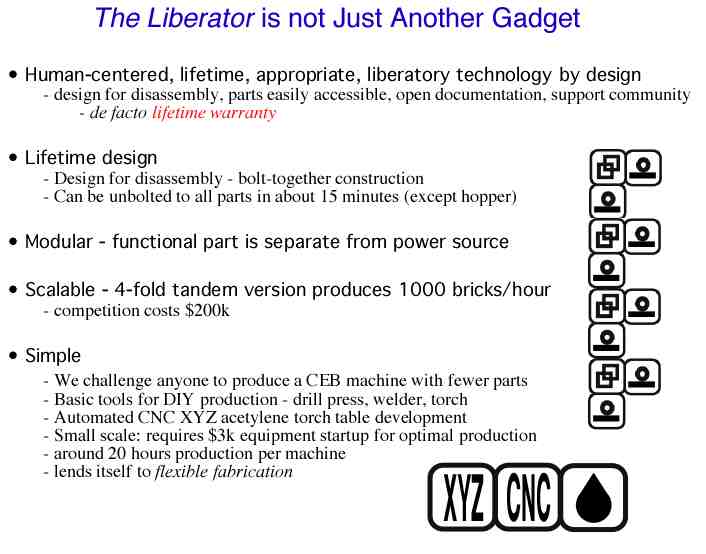Slide 21
This page was tagged as a candidate for deletion. If this page does not meet our criteria for deletion, please remove this notice.
(Explanation: contents moved to Slide 1)
Slide 1 - Slide 2 - Slide 3 - Slide 4 - Slide 5 - Slide 6 - Slide 7 - Slide 8 - Slide 9 - Slide 10 - Slide 11 - Slide 12 - Slide 13 - Slide 14 - Slide 15 - Slide 16 - Slide 17 - Slide 18 - Slide 19 - Slide 20 - Slide 21 - Slide 22 - Slide 23 - Slide 24 - Slide 25 - Slide 26 - Slide 27 - Slide 28 - Slide 29 - Slide 30 - Slide 31 - Slide 32 - Slide 33
The Liberator is not just another gadget. It exemplifies the design features that we are promoting. It is lifetime, human-centered design. It is largely bolted together, and can be taken apart easily – in about 15 minutes down to all its parts. Thus, it can be maintained easily. The parts are standard, and no special components are used outside of what can be obtained readily. The machine is a module – it is separate from its power source. It is scalable: a 4-fold, tandem version can be made by putting four of these machines next to each other, making a slight modification to the hopper.
The machine is simple. It does not require special tooling to build. Moreover, we are currently building a computer-controlled XYZ acetylene torch table – for cutting all the metal automatically - for those who are interested in going into production. The XYZ table is meant to optimize the fabrication process – and is one of the necessary GVCS components which will make such local enterprise competitive with anyone around the globe. This is what we discussed with respect to the need of the GVCS in terms of making local enterprise competitive in view of global market forces.
All the tooling for such optimized production will cost $3000.
